-
> Pedr09
> MPCII - Melach ah Uziel Orh Egel έ Klein II ןיילק ה לגא רוא לאיזוא הא ךאלמ
> School of Life
> Library
> First Book Shelf
> Metamorphoses by Ovid
Scylla. In Greek mythology, Scylla[2] ( SIL-ə; Greek: Σκύλλα, pronounced [skýl̚la], Skylla) was a legendary monster that lived on one side of a narrow channel of water, opposite her counterpart Charybdis.

The two sides of the strait were within an arrow's range of each other—so close that sailors attempting to avoid Charybdis would pass dangerously close to Scylla and vice versa. Scylla made her first appearance in Homer's Odyssey, where Odysseus and his crew encounter her and Charybdis on their travels. Later myth gave her an origin story as a beautiful nymph who gets turned into a monster.
Strait of Messina. The Strait of Messina (Italian: Stretto di Messina), is a narrow strait between the eastern tip of Sicily (Punta del Faro) and the western tip of Calabria (Punta Pezzo) in the south of Italy.
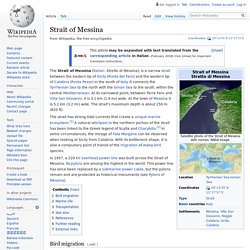
It connects the Tyrrhenian Sea to the north with the Ionian Sea to the south, within the central Mediterranean. At its narrowest point, between Torre Faro and Villa San Giovanni, it is 3.1 km (1.9 mi) wide. At the town of Messina it is 5.1 km (3.2 mi) wide. The strait's maximum depth is about 250 m (820 ft).
Circe. Depictions, even in Classical times, wandered away from the detail in Homer's narrative, which was later to be reinterpreted morally as a cautionary story against drunkenness.
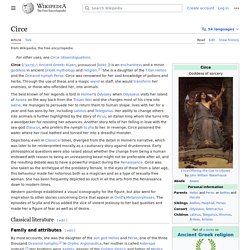
Early philosophical questions were also raised whether the change from a reasoning being to a beast was not preferable after all, and this paradox was to have a powerful impact during the Renaissance. Circe was also taken as the archetype of the predatory female. In the eyes of those from a later age, this behaviour made her notorious both as a magician and as a type of the sexually free woman. As such she has been frequently depicted in all the arts from the Renaissance down to modern times. Western paintings established a visual iconography for the figure, but also went for inspiration to other stories concerning Circe that appear in Ovid's Metamorphoses. Classical literature[edit]
Scylla. Minos. Mythological king of Crete The Minoan civilization of Crete has been named after him by the archaeologist Sir Arthur Evans. Etymology[edit] "Minos" is often interpreted as the Cretan word for "king",[1] or, by a euhemerist interpretation, the name of a particular king that was subsequently used as a title.
There is a name in Minoan Linear A mi-nu-te that may be related to Minos. According to La Marle's reading of Linear A,[2] which has been heavily criticised as arbitrary,[3] we should read mwi-nu ro-ja (Minos the king) on a Linear A tablet.
Megara. Place in Greece Megara (; Greek: Μέγαρα, pronounced [ˈmeɣara]) is a historic town and a municipality in West Attica, Greece.
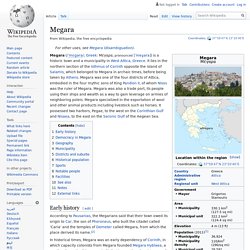
It lies in the northern section of the Isthmus of Corinth opposite the island of Salamis, which belonged to Megara in archaic times, before being taken by Athens. Megara was one of the four districts of Attica, embodied in the four mythic sons of King Pandion II, of whom Nisos was the ruler of Megara. Megara was also a trade port, its people using their ships and wealth as a way to gain leverage on armies of neighboring poleis.
Nisos. We ask you, humbly, to help.
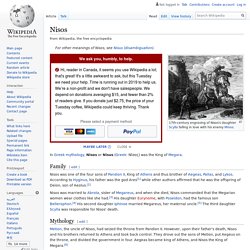
Hi, reader in Canada, it seems you use Wikipedia a lot; that's great! It's a little awkward to ask, but this Tuesday we need your help.
Saturn. Sixth planet from the Sun in the Solar System Physical characteristics Composite image comparing the sizes of Saturn and Earth Saturn is a gas giant because it is predominantly composed of hydrogen and helium.

It lacks a definite surface, though it may have a solid core.[23] Saturn's rotation causes it to have the shape of an oblate spheroid; that is, it is flattened at the poles and bulges at its equator.
Cronus. Tartarus. Greek mythology[edit] In Greek mythology, Tartarus is both a deity and a place in the underworld.
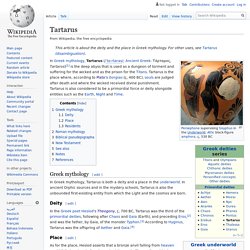
In ancient Orphic sources and in the mystery schools, Tartarus is also the unbounded first-existing entity from which the Light and the cosmos are born.
Uranus. Seventh planet from the Sun in the Solar System Like the other giant planets, Uranus has a ring system, a magnetosphere, and numerous moons.
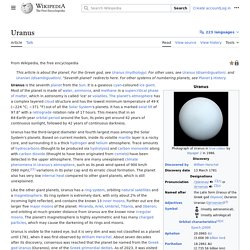
The Uranian system has a unique configuration because its axis of rotation is tilted sideways, nearly into the plane of its solar orbit. Its north and south poles, therefore, lie where most other planets have their equators.[19] In 1986, images from Voyager 2 showed Uranus as an almost featureless planet in visible light, without the cloud bands or storms associated with the other giant planets.[19] Observations from Earth have shown seasonal change and increased weather activity as Uranus approached its equinox in 2007.
Wind speeds can reach 250 metres per second (900 km/h; 560 mph).[20] Uranus is the only planet whose name is derived directly from a figure from Greek mythology, from the Latinised version of the Greek god of the sky Ouranos. History Discovery. Ops. Ancient Roman goddess of fertility and the earth In ancient Roman religion, Ops or Opis (Latin: "Plenty") was a fertility deity and earth goddess of Sabine origin.

Iconography[edit] Name[edit] The Latin word ops means "riches, goods, abundance, gifts, munificence, plenty".[2] The word is also related to opus, which means "work", particularly in the sense of "working the earth, ploughing, sowing".
[citation needed] This activity was deemed sacred, and was often attended by religious rites intended to obtain the good will of chthonic deities such as Ops and Consus.
Romulus. Legendary founder and first king of Rome Romulus () was the legendary founder and first king of Rome.

Mars. Fourth planet from the Sun in the Solar System Mars can easily be seen from Earth with the naked eye, as can its reddish coloring. Its apparent magnitude reaches −2.94, which is surpassed only by Venus, the Moon and the Sun.[12] Optical ground-based telescopes are typically limited to resolving features about 300 kilometres (190 mi) across when Earth and Mars are closest because of Earth's atmosphere.[43] Names In English, the planet is named for the Roman god of war,[44] an association made because of its red color, which suggests blood.[45] The adjectival form of Latin Mars is Martius,[46] which provides the English words Martian, used as an adjective or for a putative inhabitant of Mars, and Martial, used as an adjective corresponding to Terrestrial for Earth.[47] In Greek, the planet is known as Ἄρης Arēs, with the inflectional stem Ἄρε- Are-.[48] From this come technical terms such as areology, as well as the adjective Arean[49] and the star name Antares.
Physical characteristics Soil. Rhea Silvia. The legend[edit] Romulus would go on to found Rome, overthrow Amulius, and reinstate Numitor as King of Alba Longa. In Roman art and literature[edit] In a version presented by Ovid,[7] it is the river Anio who takes pity on her and invites her to rule in his realm.
Quirinus. In Roman mythology and religion, Quirinus ( kwi-RY-nəs,[1] Latin: [kᶣɪˈriːnʊs]) is an early god of the Roman state.
Romulus. Pythagoras. 6th century BC Ionian Greek philosopher and mystic Pythagoras of Samos[a] (c. 570 – c. 495 BC)[b] was an ancient Ionian Greek philosopher and the eponymous founder of Pythagoreanism.
Phoenix. Phoenix most often refers to: Phoenix may also refer to:
Vegetarianism. Samos. Regional unit in North Aegean, Greece. Mathematician. A mathematician is someone who uses an extensive knowledge of mathematics in his or her work, typically to solve mathematical problems.
Ancient Greek philosophy. Ionians. Pyrrha. Deucalion and Pyrrha throwing rocks that become babies.
Pyreneus. Pyramus and Thisbe. Plot[edit] In Ovid's Metamorphoses, Pyramus and Thisbe are two lovers in the city of Babylon who occupy connected houses/walls, forbidden by their parents to be wed, because of their parents' rivalry.
Pygmalion. Pygmalion or Pigmalion may refer to:
Proserpina. Ancient Roman goddess. Persephone. Procris. Procne. Priam. Pomona. Polyxena. Polyphemus. Polymestor. Polydorus. Polydectes. Pirithous. Lapiths. Picus. Phocus. Phineus. Philomela. Baucis and Philemon. Phaethon. Clymene. Apollo. Phaedra. Perseus. Perdix. Pentheus. Pelias. Peleus. Achilles. Phocus. Telamon. Aeacus.
Pegasus. Helicon. Hippocrene. Paris. Trojan War. Helen of Troy. Venus. Troy. Priam. Hecuba. Paphos. Adonis. Myrrha. Cinyras. Galathea. Pygmalion. Pan. Orpheus. Calliope. Apollo. Orithyia. Athens. Erechtheus. List of kings of Athens. Ops. Rhea. List of Roman deities. Jupiter. Saturn. Olenus. Lapiths. Ocyrhoe. Chariclo. Chiron. Nyctimene. Minerva. Lesbos. Numa Pompilius.
Romulus. Niobe. Apollo.










